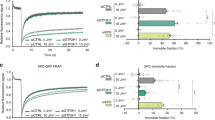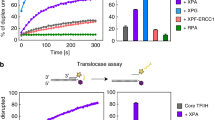Abstract
The current “working model” for mammalian base excision repair involves two sub-pathways termed single-nucleotide base excision repair and long patch base excision repair that are distinguished by their repair patch sizes and the enzymes/co-factors involved. These base excision repair sub-pathways are designed to sequester the various DNA intermediates, passing them along from one step to the next without allowing these toxic molecules to trigger cell cycle arrest, necrotic cell death, or apoptosis. Although a variety of DNA-protein and protein-protein interactions are known for the base excision repair intermediates and enzymes/co-factors, the molecular mechanisms accounting for step-to-step coordination are not well understood. In this review, we explore the question of whether there is an actual step-to-step “hand-off” of the DNA intermediates during base excision repair in vitro. The results show that when base excision repair enzymes are pre-bound to the initial single-nucleotide base excision repair intermediate, the DNA is channeled from apurinic/apyrimidinic endonuclease 1 to DNA polymerase β and then to DNA ligase. In the long patch base excision repair sub-pathway, where the 5′-end of the incised strand is blocked, the intermediate after polymerase β gap filling is not channeled from polymerase β to the subsequent enzyme, flap endonuclease 1. Instead, flap endonuclease 1 must recognize and bind to the intermediate in competition with other molecules.
Similar content being viewed by others
References
Lindahl T. 1982. DNA repair enzymes. Annu. Rev. Biochem. 51, 61–87.
Lindahl T. 1993. Instability and decay of the primary structure of DNA. Nature. 362, 709–715.
Loeb L.A., Preston B.D. 1986. Mutagenesis by apurinic/apyrimidinic sites. Annu. Rev. Genet. 20, 201–230.
Drinkwater N.R., Miller E.C., Miller J.A. 1980. Estimation of apurinic/apyrimidinic sites and phosphotriesters in deoxyribonucleic acid treated with electrophilic carcinogens and mutagens. Biochemistry. 19, 5087–5092.
Nakamura J., Swenberg J.A. 1999. Endogenous apurinic/apyrimidinic sites in genomic DNA of mammalian tissues. Cancer Res. 59, 2522–2526.
Roberts K.P., Sobrino J.A., Payton J., Mason L.B., Turesky R.J. 2006. Determination of apurinic/apyrimidinic lesions in DNA with high-performance liquid chromatography and tandem mass spectrometry. Chem. Res. Toxicol. 19, 300–309.
Horton J.K., Prasad R., Hou E., Wilson S.H. 2000. Protection against methylation-induced cytotoxicity by DNA polymerase beta-dependent long patch base excision repair. J. Biol. Chem. 275, 2211–2218.
Ward J.E. 1998. DNA repair in higher eucaryotes. In: DNA Damage and Repair. Eds. Nivkoloff J.A., Hoekstra M.F. Totowa, NJ: Humana Press, pp. 65–84.
Kubota Y., Nash R.A., Klungland A., Schar P., Barnes D.E., Lindahl T. 1996. Reconstitution of DNA base excisionrepair with purified human proteins: Interaction between DNA polymerase beta and the XRCC1 protein. EMBO J. 15, 6662–6670.
Lindahl T., Wood R.D. 1999. Quality control by DNA repair. Science. 286, 1897–1905.
Wilson D.M., 3rd, Thompson L.H. 1997. Life without DNA repair. Proc. Natl. Acad. Sci. U. S. A. 94, 12754–12757.
Wilson S.H. 1998. Mammalian base excision repair and DNA polymerase beta. Mutat. Res. 407, 203–215.
Frosina G., Fortini P., Rossi O., Carrozzino F., Raspaglio G., Cox L.S., Lane D.P., Abbondandolo A., Dogliotti E. 1996. Two pathways for base excision repair in mammalian cells. J. Biol. Chem. 271, 9573–9578.
Klungland A., Lindahl T. 1997. Second pathway for completion of human DNA base excision-repair: Reconstitution with purified proteins and requirement for DNase IV (FEN1). EMBO J. 16, 3341–3348.
Fortini P., Pascucci B., Parlanti E., Sobol R.W., Wilson S.H., Dogliotti E. 1998. Different DNA polymerases are involved in the short- and long-patch base excision repair in mammalian cells. Biochemistry. 37, 3575–3580.
Biade S., Sobol R.W., Wilson S.H., Matsumoto Y. 1998. Impairment of proliferating cell nuclear antigen-dependent apurinic/apyrimidinic site repair on linear DNA. J. Biol. Chem. 273, 898–902.
Singhal R.K., Prasad R., Wilson S.H. 1995. DNA polymerase beta conducts the gap-filling step in uracil-initiated base excision repair in a bovine testis nuclear extract. J. Biol. Chem. 270, 949–957.
Dianov G., Price A., Lindahl T. 1992. Generation of single-nucleotide repair patches following excision of uracil residues from DNA. Mol. Cell. Biol. 12, 1605–1612.
Mosbaugh D.W., Bennett S.E. 1994. Uracil-excision DNA repair. Prog. Nucl. Acids Res. Mol. Biol. 48, 315–370.
Slupphaug G., Eftedal I., Kavli B., Bharati S., Helle N.M., Haug T., Levine D.W., Krokan H.E. 1995. Properties of a recombinant human uracil-DNA glycosylase from the UNG gene and evidence that UNG encodes the major uracil-DNA glycosylase. Biochemistry. 34, 128–138.
Doetsch P.W., Helland D.E., Haseltine W.A. 1986. Mechanism of action of a mammalian DNA repair endonuclease. Biochemistry. 25, 2212–2220.
Doetsch P.W., Cunningham R.P. 1990. The enzymology of apurinic/apyrimidinic endonucleases. Mutat. Res. 236, 173–201.
Matsumoto Y., Kim K. 1995. Excision of deoxyribose phosphate residues by DNA polymerase beta during DNA repair. Science. 269, 699–702.
Piersen C.E., Prasad R., Wilson S.H., Lloyd R.S. 1996. Evidence for an imino intermediate in the DNA polymerase beta deoxyribose phosphate excision reaction. J. Biol. Chem. 271, 17811–17815.
Casas-Finet J.R., Kumar A., Morris G., Wilson S.H., Karpel R.L. 1991. Spectroscopic studies of the structural domains of mammalian DNA beta-polymerase. J. Biol. Chem. 266, 19618–19625.
Kumar A., Abbotts J., Karawya E.M., Wilson S.H. 1990. Identification and properties of the catalytic domain of mammalian DNA polymerase beta. Biochemistry. 29, 7156–7159.
Kumar A., Widen S.G., Williams K.R., Kedar P., Karpel R.L., Wilson S.H. 1990. Studies of the domain structure of mammalian DNA polymerase beta: Identification of a discrete template binding domain. J. Biol. Chem. 265, 2124–2131.
Dianov G., Lindahl T. 1994. Reconstitution of the DNA base excision-repair pathway. Curr. Biol. 4, 1069–1076.
Sobol R.W., Horton J.K., Kuhn R., Gu H., Singhal R.K., Prasad R., Rajewsky K., Wilson S.H. 1996. Requirement of mammalian DNA polymerase-beta in base-excision repair. Nature. 379, 183–186.
Srivastava D.K., Berg B.J., Prasad R., Molina J.T., Beard W.A., Tomkinson A.E., Wilson S.H. 1998. Mammalian abasic site base excision repair: Identification of the reaction sequence and rate-determining steps. J. Biol. Chem. 273, 21203–21209.
Prasad R., Beard W.A., Strauss P.R., Wilson S.H. 1998. Human DNA polymerase beta deoxyribose phosphate lyase: Substrate specificity and catalytic mechanism. J. Biol. Chem. 273, 15263–15270.
Prasad R., Singhal R.K., Srivastava D.K., Molina J.T., Tomkinson A.E., Wilson S.H. 1996. Specific interaction of DNA polymerase beta and DNA ligase I in a multiprotein base excision repair complex from bovine testis. J. Biol. Chem. 271, 16000–16007.
Prigent C., Satoh M.S., Daly G., Barnes D.E., Lindahl T. 1994. Aberrant DNA repair and DNA replication due to an inherited enzymatic defect in human DNA ligase I. Mol. Cell. Biol. 14, 310–317.
Caldecott K.W., McKeown C.K., Tucker J.D., Ljungquist S., Thompson L.H. 1994. An interaction between the mammalian DNA repair protein XRCC1 and DNA ligase III. Mol. Cell. Biol. 14, 68–76.
Mol C.D., Izumi T., Mitra S., Tainer J.A. 2000. DNA-bound structures and mutants reveal abasic DNA binding by APE1 and DNA repair coordination [corrected]. Nature. 403, 451–456.
Parikh S.S., Mol C.D., Hosfield D.J., Tainer J.A. 1999. Envisioning the molecular choreography of DNA base excision repair. Curr. Opin. Struct. Biol. 9, 37–47.
Wilson S.H., Kunkel T.A. 2000. Passing the baton in base excision repair. Nature Struct. Biol. 7, 176–178.
Prasad R., Shock D.D., Beard W.A., Wilson S.H. Substrate channeling in mammalian base excision repair pathways: Passing the baton. J. Biol. Chem. 285, 40479–40488.
Liu Y., Beard W.A., Shock D.D., Prasad R., Hou E.W., Wilson S.H. 2005. DNA polymerase beta and flap endonuclease 1 enzymatic specificities sustain DNA synthesis for long patch base excision repair. J. Biol. Chem. 280, 3665–3674.
Prasad R., Batra V.K., Yang X.P., Krahn J.M., Pedersen L.C., Beard W.A., Wilson S.H. 2005. Structural insight into the DNA polymerase beta deoxyribose phosphate lyase mechanism. DNA Repair (Amst.). 4, 1347–1357.
Sawaya M.R., Prasad R., Wilson S.H., Kraut J., Pelletier H. 1997. Crystal structures of human DNA polymerase beta complexed with gapped and nicked DNA: Evidence for an induced fit mechanism. Biochemistry. 36, 11205–11215.
Deterding L.J., Prasad R., Mullen G.P., Wilson S.H., Tomer K.B. 2000. Mapping of the 5′-2-deoxyribose-5-phosphate lyase active site in DNA polymerase beta by mass spectrometry. J. Biol. Chem. 275, 10463–10471.
Liu Y., Prasad R., Beard W.A., Kedar P.S., Hou E.W., Shock D.D., Wilson S.H. 2007. Coordination of steps in single-nucleotide base excision repair mediated by apurinic/apyrimidinic endonuclease 1 and DNA polymerase beta. J. Biol. Chem. 282, 13532–13541.
Wong D., Demple B. 2004. Modulation of the 5′-deoxyribose-5-phosphate lyase and DNA synthesis activities of mammalian DNA polymerase beta by apurinic/apyrimidinic endonuclease 1. J. Biol. Chem. 279, 25268–25275.
Tomkinson A.E., Chen L., Dong Z., Leppard J.B., Levin D.S., Mackey Z.B., Motycka T.A. 2001. Completion of base excision repair by mammalian DNA ligases. Prog. Nucl. Acids Res. Mol. Biol. 68, 151–164.
Lavrik O.I., Prasad R., Sobol R.W., Horton J.K., Ackerman E.J., Wilson S.H. 2001. Photoaffinity labeling of mouse fibroblast enzymes by a base excision repair intermediate: Evidence for the role of poly(ADP-ribose) polymerase-1 in DNA repair. J. Biol. Chem. 276, 25541–25548.
Zolghadr K., Mortusewicz O., Rothbauer U., Kleinhans R., Goehler H., Wanker E.E., Cardoso M.C., Leonhardt H. 2008. A fluorescent two-hybrid assay for direct visualization of protein interactions in living cells. Mol. Cell. Proteomics. 7, 2279–2287.
Lan L., Nakajima S., Oohata Y., Takao M., Okano S., Masutani M., Wilson S.H., Yasui A. 2004. In situ analysis of repair processes for oxidative DNA damage in mammalian cells. Proc. Natl. Acad. Sci. U. S. A. 101, 13 738–13743.
Author information
Authors and Affiliations
Corresponding author
Additional information
The article is published in the original.
Rights and permissions
About this article
Cite this article
Prasad, R., Beard, W.A., Batra, V.K. et al. A review of recent experiments on step-to-step “hand-off” of the DNA intermediates in mammalian base excision repair pathways. Mol Biol 45, 536–550 (2011). https://doi.org/10.1134/S0026893311040091
Received:
Accepted:
Published:
Issue Date:
DOI: https://doi.org/10.1134/S0026893311040091




